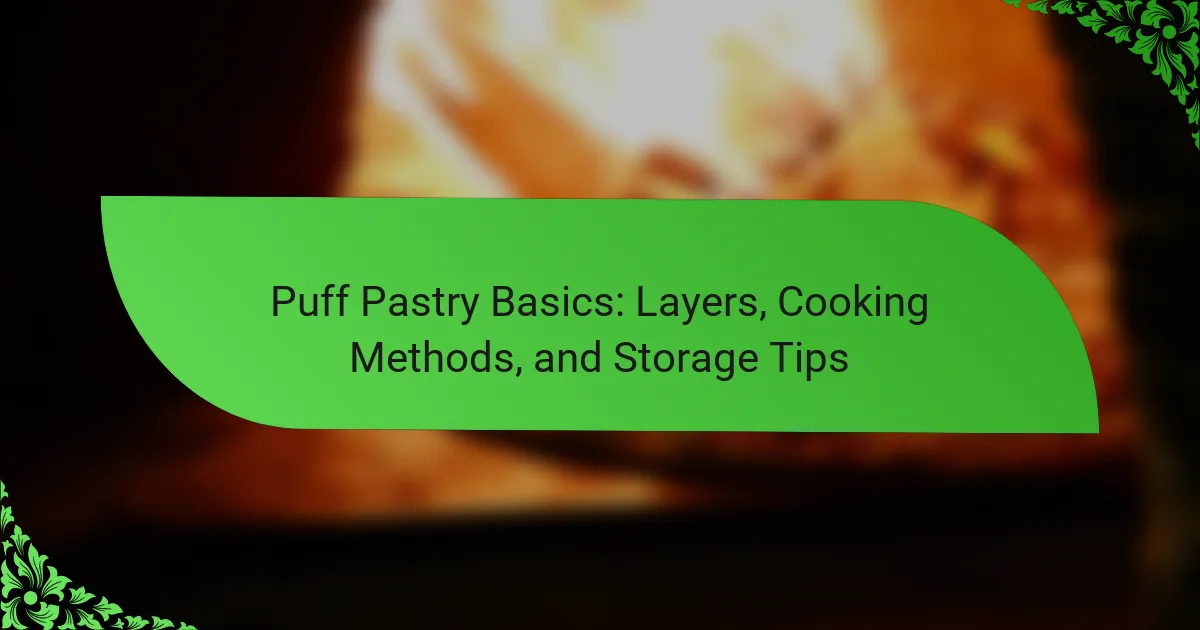Puff pastry is a light, flaky pastry created from layers of dough and butter, primarily composed of flour, water, salt, and a significant amount of butter. The lamination process involves rolling and folding the dough to form thin layers, which puff up when baked due to steam from the butter. This versatile pastry is used in various sweet and savory dishes, including tarts, turnovers, and pastries, and can be cooked through baking, frying, or steaming. Proper storage methods, such as refrigerating or freezing, are essential to maintain its flaky texture and quality, with specific guidelines provided for optimal freshness. The article delves into the fundamentals of puff pastry, covering its preparation, cooking techniques, and storage tips.

What is Puff Pastry?
Puff pastry is a light, flaky pastry made from layers of dough and butter. It consists of a simple mixture of flour, water, and salt, combined with a significant amount of butter. The dough is repeatedly rolled and folded to create thin layers. This process is known as lamination. When baked, the water in the butter creates steam, causing the layers to puff up. Puff pastry is commonly used in both sweet and savory dishes. Its versatility allows it to be shaped into various forms, such as tarts, turnovers, and pastries. The history of puff pastry dates back to ancient times, with records indicating its use in French cuisine during the Renaissance.
How is Puff Pastry made?
Puff pastry is made by creating layers of dough and butter through a process called lamination. First, a dough is prepared using flour, water, and salt. This basic dough is often referred to as the “detrempe.” Next, a block of cold butter is prepared, which is known as the “beurrage.” The butter is rolled out into a flat square. The detrempe is then enveloped around the beurrage, forming a package. This package is rolled out into a thin sheet and folded multiple times to create layers. Typically, the dough undergoes three to six folds, with resting periods in between to keep the dough cold. Each fold multiplies the layers, resulting in a flaky texture when baked. The final product expands in the oven due to steam, creating the characteristic puff of puff pastry.
What are the key ingredients in Puff Pastry?
The key ingredients in puff pastry are flour, butter, water, and salt. Flour provides the structure necessary for the pastry. Butter is essential for creating the flaky layers through lamination. Water is added to hydrate the flour and bind the ingredients together. Salt enhances the flavor of the pastry. These ingredients work together to produce the characteristic light and airy texture of puff pastry.
What is the role of butter in Puff Pastry?
Butter plays a crucial role in puff pastry by creating layers and providing richness. The high-fat content of butter contributes to the pastry’s flakiness. When butter is incorporated into the dough, it creates steam during baking. This steam causes the layers to separate and puff up. The result is a light and airy texture. Additionally, butter enhances the flavor of the pastry. The combination of fat and moisture is essential for achieving the desired consistency. Overall, butter is fundamental to the structure and taste of puff pastry.
Why is layering important in Puff Pastry?
Layering is crucial in puff pastry because it creates the desired flaky texture. The process involves folding and rolling dough with butter multiple times. Each layer of dough traps steam during baking. This steam causes the layers to puff up. The result is a light and airy pastry. Without proper layering, the pastry would be dense and chewy. The traditional method includes at least six folds to achieve optimal layers. This technique has been used in pastry making for centuries.
How does the layering process affect texture?
The layering process significantly affects the texture of puff pastry. It creates distinct layers that contribute to a light and flaky structure. Each layer consists of dough and butter, which, when baked, puff up due to steam. This steam separates the layers, resulting in a tender and airy texture. The more layers created, the more pronounced the flakiness becomes. A standard puff pastry may have over 700 layers, enhancing its texture. This unique structure is essential for achieving the desired mouthfeel in baked goods.
What techniques are used to create layers?
Techniques used to create layers in puff pastry include lamination and folding. Lamination involves rolling dough with layers of butter, then folding it multiple times. This process creates thin sheets of dough separated by butter. Each fold multiplies the layers, increasing flakiness. The dough is typically rolled out, then folded into thirds or quarters. This method can be repeated several times to achieve a desired number of layers. The final product often has hundreds of layers, contributing to its light texture.
What are the different types of Puff Pastry?
The different types of puff pastry include classic puff pastry, rough puff pastry, and flaky pastry. Classic puff pastry is made by folding butter into dough multiple times to create many layers. This method results in a light and airy texture when baked. Rough puff pastry simplifies the process by incorporating butter into the dough without extensive folding. It still produces a layered effect but with less work. Flaky pastry, often used for pies, has a different fat-to-flour ratio and creates a more crumbly texture. Each type serves specific culinary purposes, enhancing various dishes.
What is the difference between classic and rough Puff Pastry?
Classic puff pastry involves a precise lamination technique, where dough and butter are folded together multiple times to create many layers. This method results in a lighter, flakier texture. Rough puff pastry, on the other hand, simplifies the process by incorporating butter into the dough in larger chunks. This results in fewer layers and a denser texture. The classic method typically requires more time and skill, while the rough method is quicker and easier for home bakers. Both types of pastry can be used in similar recipes, but the final texture and flakiness will vary significantly.
How does each type affect the final product?
Each type of puff pastry affects the final product through its layers and fat content. Classic puff pastry has many layers that create a light, flaky texture. The more layers present, the greater the rise during baking. This rise is due to the steam created by the fat melting between the layers.
Rough puff pastry has fewer layers, resulting in a denser texture. It is quicker to make but sacrifices some flakiness. The use of larger chunks of fat in rough puff pastry leads to a more rustic appearance.
Phyllo dough, while not a traditional puff pastry, produces a different final product. It is thin and crispy rather than flaky. Each layer must be brushed with fat to create the desired texture.
The choice of type impacts baking time and temperature as well. Classic puff pastry requires a higher temperature to achieve maximum rise. Rough puff and phyllo may require adjustments in these areas for optimal results.

What are the cooking methods for Puff Pastry?
Puff pastry can be cooked using baking, frying, or steaming methods. Baking is the most common method, where pastry is placed in a preheated oven. The heat causes the layers to expand and create a flaky texture. Frying involves cooking puff pastry in hot oil, resulting in a crispy exterior. Steaming can also be used, which retains moisture and creates a different texture. Each method affects the final product’s texture and flavor, making it versatile for various dishes.
How do you properly bake Puff Pastry?
To properly bake puff pastry, first preheat the oven to 400°F (200°C). Roll out the puff pastry to your desired thickness on a floured surface. Cut it into shapes or sizes as needed for your recipe. Place the pastry on a baking sheet lined with parchment paper. Brush the surface with an egg wash for a golden finish. Bake for 15 to 20 minutes until the pastry is puffed and golden brown. Ensure that the internal temperature reaches at least 190°F (88°C) for optimal texture. Following these steps ensures a flaky and well-cooked puff pastry.
What temperature is ideal for baking Puff Pastry?
The ideal temperature for baking puff pastry is 400°F (200°C). This high temperature allows the layers of dough to rise effectively. Baking at this temperature creates steam, which is essential for puffing. A hot oven ensures that the outer layers become crisp and golden. Many pastry chefs recommend preheating the oven to achieve optimal results. Consistent heat helps maintain the pastry’s structure during baking. Following this guideline leads to a well-risen and flaky puff pastry.
How long should Puff Pastry be baked for optimal results?
Puff pastry should be baked for 15 to 20 minutes at 400°F (200°C) for optimal results. This baking time allows the layers to rise and become golden brown. The high temperature is crucial for achieving the desired flakiness. Proper baking ensures that the pastry cooks evenly throughout. A visual cue is the pastry’s puffed appearance and golden color. These characteristics indicate that the pastry is fully cooked. Following this guideline will yield the best texture and flavor.
What alternative cooking methods can be used for Puff Pastry?
Puff pastry can be cooked using alternative methods such as frying, grilling, and baking in a microwave. Frying puff pastry creates a crispy texture and is suitable for savory fillings. Grilling can add a unique flavor while also providing a crispy exterior. Microwaving puff pastry is a quick option, although it may not yield the same crispiness as traditional baking. These methods allow for versatility in preparing puff pastry dishes.
Can Puff Pastry be fried or grilled?
Yes, puff pastry can be fried or grilled. Frying puff pastry creates a crispy texture and enhances its flavor. Grilling puff pastry can also yield a unique taste and appearance. Both methods require careful temperature control to prevent burning. Fried puff pastry is often used in desserts and savory dishes. Grilled puff pastry can be paired with various toppings or fillings. These cooking methods are less common than baking but are effective for diverse culinary applications.
What are the pros and cons of each cooking method?
The pros and cons of each cooking method for puff pastry include baking, frying, and steaming. Baking is the most common method. It produces a flaky, golden crust. However, baking requires precise temperature control. Frying creates a crispy texture quickly. It can also add excess oil, affecting healthiness. Steaming retains moisture but may result in a less crispy texture. Each method has its advantages and drawbacks, influencing the final outcome of the puff pastry.

How should Puff Pastry be stored?
Puff pastry should be stored in the refrigerator or freezer. When refrigerating, wrap it tightly in plastic wrap to prevent drying out. This method keeps it fresh for up to three days. For longer storage, place the wrapped pastry in an airtight container or freezer bag. This allows it to last for up to three months in the freezer. Always thaw frozen puff pastry in the refrigerator before using it. Proper storage ensures the pastry maintains its flaky texture and quality.
What is the best way to store uncooked Puff Pastry?
The best way to store uncooked puff pastry is to keep it in the refrigerator or freezer. For short-term storage, wrap the pastry tightly in plastic wrap and place it in the refrigerator. This keeps it fresh for up to three days. For longer storage, freeze the wrapped pastry. It can last up to two months in the freezer. When ready to use, thaw the pastry in the refrigerator overnight. This method maintains the pastry’s texture and prevents it from drying out.
How long can uncooked Puff Pastry be kept in the fridge or freezer?
Uncooked puff pastry can be kept in the fridge for up to 3 days. If stored in the freezer, it can last for about 1 to 2 months. Proper storage is crucial for maintaining its quality. In the fridge, ensure it is wrapped tightly to prevent drying out. In the freezer, use an airtight container or heavy-duty freezer bag. This helps to avoid freezer burn. Following these guidelines ensures the pastry remains usable for cooking.
What tips ensure freshness when storing Puff Pastry?
To ensure freshness when storing puff pastry, wrap it tightly in plastic wrap. This prevents moisture loss and protects against freezer burn. Store it in an airtight container for added protection. Keep puff pastry in the refrigerator if using within a few days. For longer storage, place it in the freezer, where it can last for up to three months. Thaw frozen puff pastry in the refrigerator overnight before use. Avoid refreezing thawed pastry to maintain quality. These methods help preserve the flaky texture and flavor of puff pastry.
How should cooked Puff Pastry be stored?
Cooked puff pastry should be stored in an airtight container. This prevents moisture from making the pastry soggy. It is best to keep it at room temperature for up to two days. For longer storage, refrigerate it to maintain freshness. When refrigerating, ensure the container is sealed tightly. Reheating is recommended before serving to restore crispness. Avoid freezing cooked puff pastry, as it can alter the texture negatively. Proper storage is essential for maintaining the quality of the pastry.
What are the best practices for reheating cooked Puff Pastry?
To reheat cooked puff pastry effectively, use an oven set to 350°F (175°C). This temperature ensures even heating without compromising texture. Place the puff pastry on a baking sheet lined with parchment paper. Reheat for about 10-15 minutes or until the pastry is warmed through and crispy. Avoid using a microwave, as it can make the pastry soggy. The oven method preserves the flaky layers and original taste. Proper reheating enhances enjoyment of the dish.
How does storage affect the quality of cooked Puff Pastry?
Storage significantly impacts the quality of cooked puff pastry. When stored improperly, puff pastry can lose its flaky texture and become soggy. Exposure to moisture in the air leads to a loss of crispness. Refrigerating cooked puff pastry can cause it to absorb moisture, resulting in a chewy consistency. Ideally, cooked puff pastry should be stored in an airtight container at room temperature. This method helps maintain its crispiness for a limited time. Consuming it within a day or two ensures the best quality. For longer storage, freezing is an option, but it may alter texture upon reheating.
What are some common troubleshooting tips for Puff Pastry?
Use cold ingredients to prevent the butter from melting. This helps maintain distinct layers. Roll the dough evenly to ensure uniform thickness. Uneven thickness can lead to uneven baking. Chill the dough between folds to keep it firm. This step enhances the flakiness. Avoid overworking the dough to prevent tough pastry. Overworking can cause gluten development. Preheat the oven properly for optimal rise. A hot oven ensures the steam creates lift. Use parchment paper to prevent sticking during baking. This facilitates easy removal of the pastry.
What should you do if Puff Pastry doesn’t rise properly?
If puff pastry doesn’t rise properly, check the temperature of your oven. The ideal baking temperature for puff pastry is typically around 400°F (200°C). Insufficient heat can prevent the layers from expanding. Ensure the pastry is cold before baking. Cold pastry helps maintain the integrity of the layers. Additionally, verify that you used enough butter in the lamination process. Butter creates steam, which is essential for puffing. Lastly, avoid overcrowding the baking sheet. Proper spacing allows hot air to circulate and promotes even rising.
How can you fix a soggy bottom in Puff Pastry dishes?
To fix a soggy bottom in puff pastry dishes, pre-bake the pastry before adding fillings. This technique creates a barrier that prevents moisture from seeping in. Use a fork to dock the pastry, allowing steam to escape. Bake at a high temperature for the initial phase, which helps achieve a crisp texture. Additionally, consider using a layer of dry ingredients, like breadcrumbs or crushed crackers, under the filling. This absorbs excess moisture and maintains crispness. Implementing these methods effectively reduces sogginess in puff pastry dishes.
Puff pastry is a light, flaky pastry made from layers of dough and butter, created through a technique called lamination. This article covers the key ingredients, methods of preparation, and various types of puff pastry, including classic and rough puff pastry. It also explores cooking methods such as baking, frying, and steaming, along with best practices for storage and reheating to maintain quality. Troubleshooting tips for common issues, such as rising problems and soggy bottoms, are also provided to ensure successful puff pastry dishes.
